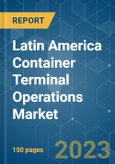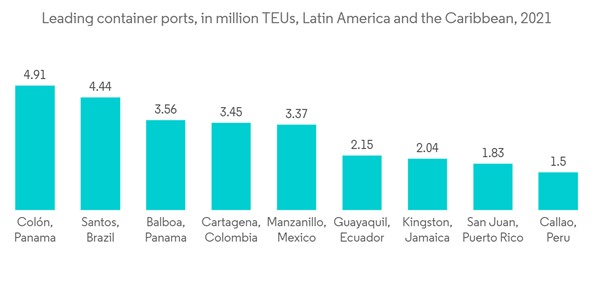Key Highlights
- The supply chain in the maritime industry has been facing a series of challenges since the start of the COVID-19 pandemic in early 2020. Port closures due to coronavirus outbreaks, port congestions, rising prices of bunker fuel, and problems with capacity utilization were plaguing the marine port services industry for most of 2020 and 2021. Due to the pandemic, the volume of containers transported shrank by about 0.2 percent in 2020. On the other hand, the recent spike in container freight rates turned out extremely profitable for marine port services operators, who reported record-high profit margins in 2021.
- Container terminal services are very complex and mainly depend upon the nature of shipment and cargo. Cargo can be anything cars, merchandise, crude oil, mineral, and other types.
- The evolution of supply chains and logistics models has caused container terminals to rethink their logistics processes. The concept of ports and their functions have evolved over the decades.
- A different set of machinery, expertise, and workforce is required to handle and manage other types of cargo. The ferry services require different types of ports for their handling. The lack of efficiency in operations at the container terminal is not desirable and can also lead to accidents. So the container terminal operations should be highly efficient and flawless. Therefore container terminal operations are the core of the maritime industry.
- With the advent of digital technology, ports have become more automated, interconnected supply chains, and limited workforce to perform operations. As a result, various investments are being made in port automation to increase port efficiency.
- New technology companies are poised to transform South America's shipping and freight industry. Startups like Newport's, a Mexican freight shipping startup, are angling to be the next Convoy and Flexport - when the shipping and logistics business in South America is booming thanks to increasing trade from China.
- South American countries are observing an increasing number of international companies entering and expanding in the region to take advantage of the growing opportunities.
- The expansion of the Panama Canal has inspired the development of ports in the Latin America and the Caribbean (LAC) region, seeking to capitalize on economic opportunities through maritime trade.
Latin America Container Terminal Operations Market Trends
Rise in Container Seaborne Trade
In 2021, Panama's Port of Colon handled the largest cargo container in Latin America and the Caribbean, handling approximately 4.91 million TEUs. Brazil's port of Santos followed closely behind with 4.44 million TEUs of cargo. Balboa, on the Pacific side of the Panama Canal, was also among the top five Latin American ports of the year. Nevertheless, the region's trade volume has grown significantly over the past decade, and countries in the region rely heavily on container shipping to develop and sustain their economies. The Panama Canal, which connects the Pacific and Atlantic oceans is located in Latin America. Moreover, with the advent of digitalization and ongoing globalization, Latin American countries are striving more than ever to become part of the global economy. The ports of this continent boost the industrial development and economy of each country, thereby enhancing the consumption power of the entire continent. Logistics companies that regularly ship cargo to and from Latin America, or work with agents on this continent,use one of the continent's 453 ports.Port of Colon, Panama- Located on the Atlantic side of Panama, the Port of Manzanillo covers an area of ??58 hectares. However, the port authority plans to expand the port area by another 100 hectares. The port handles over 140,000 of Ro-Ro vehicles daily. In addition, between 1.9 million and 2.1 million TEUs of cargo are processed annually. Port of Santos, Brazil- Located just 70 miles from Sao Paulo, Brazil's most populous city, the Port of Santos is one of the country's premier ports. With enormous logistics capacity, the port is also known as one of the most modern ports on the continent. The city of Santos is one of the most important trade routes in Brazil. Most importantly, about 27% of Brazil's trade balance passes through this port. Port of Santos is connected to over 600 ports in 125 countries. Major cargoes transported to and from Santos Port include wheat, sugar, oil, soybeans, alcohol, machinery, paper, automobiles, cotton oranges and fertilizers.
Increasing Maritime Trade
In Latin America and the Caribbean, flags accounted for 21.5% of the global fleet in 2021. Considering the total merchant fleet by registered flag expressed in thousands of dead weight tons (DWT), Panama ranked first on the list, accounting for 16.1% of the merchant fleet in 2021, according to UNCTADSTAT (2022). In recent years, Latin America and the Caribbean account for about 17% of all seaborne freight worldwide. However, the regional share of the shipping industry is smaller. Most of Latin America's largest countries have their own shipping companies (privately or publicly funded) until 20-30 years ago, but in reality, the influence of the companies remaining in the market is much smaller.The shipping industry in Latin America and the Caribbean has the unique characteristics of companies in this industry that are largely privately owned, have a small fleet, and are not too remote in geographical reach and diverse expertise. The Panama Canal (PC) is the shortest functioning route linking maritime trade between the Atlantic and Pacific oceans. It is also the shortest route for gas cargo from the Gulf of Mexico to North Asia. The Panama Canal (PC) is vital to global trade, with more than USD 270 billion in cargo passing through the canal each year. It serves over 140 sea routes in over 80 countries. The expansion was completed on 26 June 2016, allowing passage for Neo-Panamax and some Post-Panamax vessels. This increased port competition, trade, cargo tonnage and shipping activity within the Latin America region.
Latin America Container Terminal Operations Market Competitor Analysis
The Market is relatively fragmented, with many local and International players like Brasil Terminal Portuário S.A., Santos Brasil Participacoes S/A, Maranhense Port Administration Company (EMAP)., APM Terminals Callao, The Port of Cartagena Organization. The Market is expected to show positive growth in the forecast period as many companies are jumping into the Market.The private port operators have significantly improved the efficiency and productivity of cargo management, making LAC more competitive. Especially in Latin American and Caribbean ports, operational efficiency has increased by more than 20% since the turn of the 20th century. Data show that private sector engagement and port competition correlate with higher operational and economic performance and better-maintained ports.
Additional Benefits:
- The market estimate (ME) sheet in Excel format
- 3 months of analyst support
Table of Contents
Companies Mentioned (Partial List)
A selection of companies mentioned in this report includes, but is not limited to:
- Brasil Terminal Portuário S.A.
- Santos Brasil Participacoes S/A
- Maranhense Port Administration Company (EMAP).
- APM Terminals Callao
- The Port of Cartagena Organization
- Santos Port Authority
- San Lorenzo Port Authority
- DP World
- Hutchinson Ports PPC
- Kingston Wharves Limited
Methodology

LOADING...









